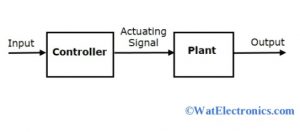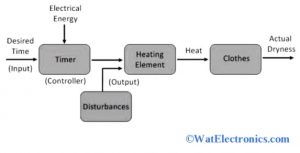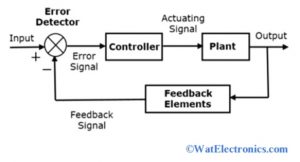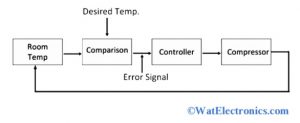In 1767, James Watt’s Flyball governor invented a device called a control system to control the constant speed of the engine with the regulation of the speed of the steam supply to the engine. When the output of the system is regulated or controlled by varying the input, then such a type of system is called a control system. The function of the control system is determined by the differential equations (ordinary or difference equations). It can manage, command, direct and regulate the function of a system or other devices to obtain better or desired results. The control system plays an important role in the development of modern technology. It gives the relationship between the input and output of a system mathematically in the form of linear proportionality. Hence it is also known as a linear control system. The Open Loop and Closed Loop are the two types of control systems. This article gives a brief description of the differences between open Loop control systems and closed-loop control systems with an example.
What is an Open Loop Control System?
The Open Loop control system is one of the types of control systems. The obtained output is independent of the system’s control action. The working of the Open Loop control system depends on time and a feedback element is absent. It is referred to as a non-linear control system or a manual control system. The block diagram of the Open Loop control system is shown below.

Open Loop Control System
When the input signal is applied to the controller, a control signal or actuating signal is obtained. The output of the controller is given to the controlled processor or processor to process the signal and obtain the desired output, which is also called a controlled output. As there is no feedback path, the desired output obtained from the process. So, the output obtained from the controller process is not considered and compared with the given input signal in the future.
Generally, an error may occur in the system during the process of the control signal. But there is no chance to adjust the given input signal with the desired output signal when there is a difference between them. Electric hand dryer, automatic washing machine, toaster, traffic light control system, tea maker, clothes dryer with time, stereo system, remote controls, room heaters, automatic doors are some of the examples of Open Loop control systems.
The Open Loop control system is easy, economical, and fast. The accuracy of the system is less because the desired output will not be equal to the given input signal. It is also known as a non-linear control system.
Example 1: Clothes Dryer
The control action of the clothes dryer is done by an operator manually. When the operator sets the timer for 20 minutes to dry the wet clothes, the timer will stop the control action dryer even though the clothes are wet. That means the dryer stops working after 20minutes because of no feedback path. Hence, the output obtained is not compared with the reference input. The timer of the clothes dryer acts as a controller unit.

Example of Clothes Dryer
Example 2: Automatic Washing Machine
When the timer of the washing machine is set by an operator manually, it stops working after the time even if the required cleanliness is not obtained. Because of no feedback signal, the machine cannot recognize that the desired output is not obtained.
What is Closed-Loop Control System?
The control system in which the output obtained from the system is dependent on the given input. The control action of the system is based on the desired output. A feedback path is provided to convert an open Loop control system into a closed-loop control system. Due to the external interference, the provided feedback helps to make changes in the output regarding the input automatically. Hence it is also called an automatic control system. The block diagram of the Closed Loop control system is shown below.

Closed-Loop Control System
From the above diagram, the feedback path is provided from the output and it is applied back to the input to compare and adjust. An error signal produced by an error detector is the difference between a feedback signal and an input signal. Here the feedback signal is an overall output of the system, which is taken as input to get the desired output and reduce the error. This feedback signal might be positive or negative.
When an error signal generated by an error detector is fed to a controller, an actuating signal or control signal is produced. The output of the controller is processed in the plant or processor to get the desired output. The feedback path of the system will help to compare and adjust the output as required. Automatic electric iron, servo voltage stabilizer, traffic light control system using sensors, water level controller, Radars, air conditioners, the cooling system in the car, are some of the examples of Closed-loop control systems.
The Closed Loop control system is more accurate, reliable, and costlier due to the feedback path (feedback element).
Example 1: An Air Conditioner (AC)
The block diagram of an air conditioner using Closed Loop control system technology is shown below. The working of an AC is based on room temperature.

Example of Air Conditioner
The temperature of an AC is regulated or controlled by comparing it with the temperature of the room. The thermostat is used to compare the temperature. An error signal is generated by an AC, which is the difference between the surrounding temperature and the room temperature. Based on this, the thermostat turns ON or OFF the compressor.
Example 2: Water Level Controller
The water input is controlled by the water level of the reservoir or water tank.
Key Differences between Open Loop & Closed Loop Control System
The key differences between open-loop and closed-loop control system are given in a tabular form
| Open Loop Control System | Closed-Loop Control System |
| It is also known as a non-feedback control system, where the preferred output doesn’t depend on the control action of the system | It is also known as a feedback control system, where the preferred output will depend on the control action of the system. |
| It requires controlled processor and controller components | It requires a controller, controlled processor, feedback path, and amplifier. |
| Easy in construction | Difficult in construction |
| It is a non-reliable control system | It is reliable |
| The accuracy of the system is less and depends on the calibration | This system is more accurate due to feedback. |
| It is a stable system | The stability of the system is less |
| Optimization is not possible | Optimization is possible |
| The response of the system is fast | Response of the system is slow |
| It doesn’t require a feedback element and an error detector | It requires a feedback element and an error detector. |
| The bandwidth of the system is small | The bandwidth of the system is more |
| Maintenance is easy and less | Maintenance is complex and more |
| It is available at affordable rates | The cost of the system is more |
| Calibration of the system is complex | Calibration of the system is simple |
| 14. Non-linear Open Loop control system.
Examples: traffic lights, automatic washing machines, hand driers, tea maker, televisions, remote control unit, immersion rod, and many more |
14.Linear Closed Loop control system
Examples: voltage stabilizers, perspiration systems, AC (air conditioner), temperature-controlled systems, pressure and speed controlled systems, fridges, toasters. |
Examples: Traffic lights, automatic washing machines, hand driers, tea makers, televisions, remote control unit, immersion rod, and many more 14.Linear Closed Loop control system
Examples: voltage stabilizers, perspiration systems, AC (air conditioner), temperature-controlled systems, pressure and speed controlled systems, fridges, toasters.
Know more about Distributed Control System.
Please refer to this link to know more about Control System MCQs
Thus, this is all about the types of control system with examples- open-loop control system and closed-loop control system, the key difference between open-loop control system and closed-loop control system. The purpose of the control system is to produce and regulate the desired output obtained based on the input signal. Here is a question for you, “What are the advantages and disadvantages of open-loop and closed-loop control systems? “